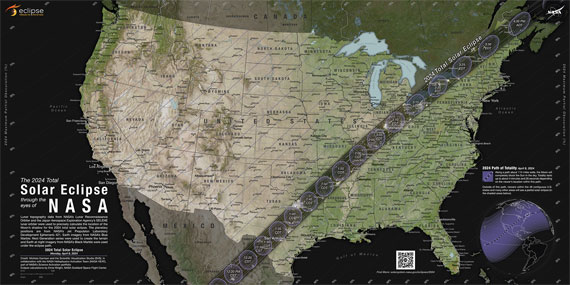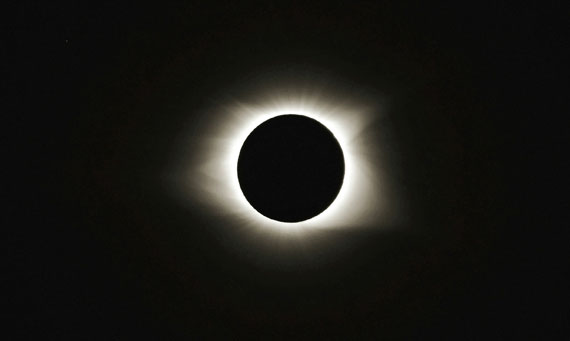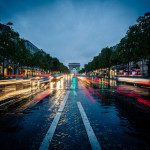The total solar eclipse of 2024 is an eagerly anticipated event for astronomers, enthusiasts, and photographers around the globe. Capturing this celestial phenomenon requires preparation, the right equipment, and a bit of know-how. Here’s your comprehensive guide to photographing the 2024 total solar eclipse.
On April 8, 2024, a total solar eclipse will cross North and Central America creating a path of totality.

Credit: NASA‘s Scientific Visualization Studio
The dark path across the map is where the largest area of the Sun will be covered by the Moon. People in this path will experience a total solar eclipse.
1. Understand the Phenomenon
Before you set out to photograph the eclipse, it’s crucial to understand what you’re about to witness. A total solar eclipse occurs when the moon passes between the Earth and the sun, completely blocking the sun’s light. This event unfolds in phases – partial eclipse, total eclipse, and then partial eclipse again.
2. Choose the Right Equipment
- Camera: A DSLR or a mirrorless camera with manual settings is ideal. You can also use a point-and-shoot camera with manual mode or even a smartphone with a good camera.
- Lens: A telephoto lens (200mm or longer) is recommended to capture detailed images of the eclipse.
- Tripod: A sturdy tripod is essential to stabilize your camera, especially during the longer exposures required for eclipse photography.
- Solar Filters: You must use a certified solar filter over your lens to protect your camera sensor (and your eyes) from the intense sunlight.
For more advanced gear & settings, check out LensRentals Eclipse Plan
3. Select Your Location
Scout for a location with a clear view of the sky. High elevation and minimal light pollution can contribute to a better photographic experience. Ensure your chosen spot is within the path of totality to capture the full effect of the eclipse.
4. Practice and Prepare
- Practice: Test your equipment and practice your settings in the days leading up to the eclipse. Familiarize yourself with your camera’s manual mode to adjust shutter speed, aperture, and ISO quickly.
- Prepare: Charge your batteries, clear your memory cards, and have all your equipment ready. Consider bringing backup equipment if possible.
5. Camera Settings
- Manual Mode: The dynamic range of the eclipse requires you to switch between settings rapidly. Start with a low ISO (100-400), a small aperture (around f/8 to f/16), and adjust the shutter speed according to the brightness.
- Focus: Use manual focus and set it to infinity. You can practice focusing on a distant object to ensure sharpness.
- Bracketing: Since the lighting conditions change rapidly, consider using exposure bracketing to capture a range of exposures.

Photo captured by Jan Haerer
6. During the Eclipse
- Partial Phases: Use your solar filter to photograph the phases leading up to and following totality. Change your settings as the light dims.
- Totality: This is the only time you can safely remove your solar filter to capture the corona’s exquisite details. Adjust your settings to capture the dimmer light – this might include increasing the ISO or using a longer shutter speed.
- Safety: Never look directly at the sun without proper eye protection, and ensure your camera’s viewfinder is not used to observe the sun unless you have a solar filter attached.
7. Share Your Experience
Eclipse photography is not just about the technical details; it’s also about sharing this rare celestial event’s awe and beauty. Share your images with the community, engage with other photographers, and discuss your experiences and techniques.
Photographing a total solar eclipse is a thrilling experience that combines the art of photography with the grandeur of the cosmos. With the right preparation and technique, you can capture stunning images that encapsulate the awe-inspiring beauty of this celestial event. Happy shooting, and here’s to hoping for clear skies in 2024!
For a cheat sheet you can print and take with you: Printable Photo Cheat Sheets
Like This Article?
Don't Miss The Next One!
Join over 100,000 photographers of all experience levels who receive our free photography tips and articles to stay current:






Leave a Reply